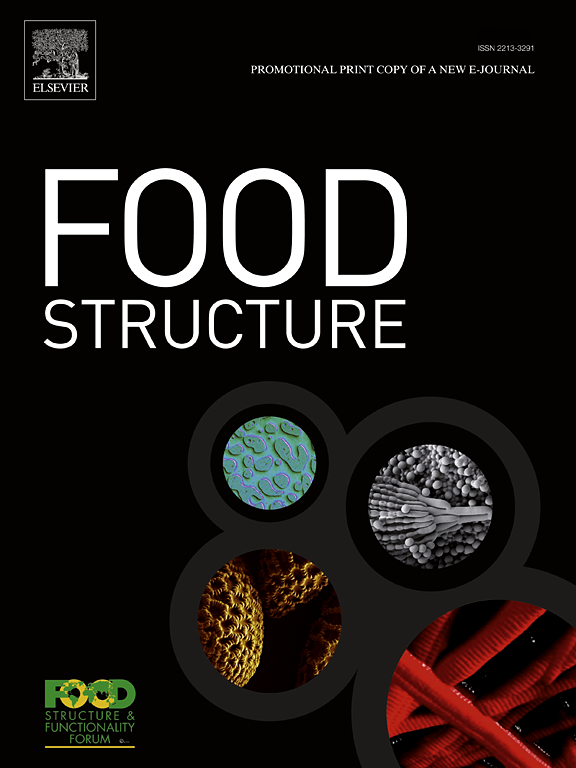Process-induced protein aggregates influenced pea globulins’ structure formation upon heating
IF 5.6
3区 农林科学
Q1 FOOD SCIENCE & TECHNOLOGY
引用次数: 0
Abstract
Pea protein ingredients play key role in formulations of plant-based foods. However, functional properties of pea ingredients are inconsistent depending on extraction process. Protein aggregation occurs simultaneously during protein extraction, thus examining the protein aggregated states as induced by processing is essential for better process design. This study investigated the influence of process-induced protein aggregated states on structure formation upon heating of pea protein ingredients. Combining rheological, spectroscopic, and microscopic techniques, the mechanisms underlining heat-induced structure formation have been unveiled from microscopic to macroscopic scales. The salt-extracted isolate (PPI*) where protein aggregation was minimized, developed mesh-like structure through intermolecular protein-protein interaction upon gelling similar to commercial protein concentrate (PPC). In turn, commercial isolate (PPI) as appeared as microscopic particles, formed gel through accumulation of protein particles with no structure development. The aggregated states of PPI* and PPI seemed to dictate vicilin and legumin purification by means of anion exchange chromatography. Purification process promoted intermolecular protein aggregate structures. However, these purified fractions regardless of parent isolates showed similar structure development as PPC and PPI* during gelling. Monitoring protein aggregation during extraction process can be a key to limit functional property variation in pea protein ingredients.
工艺诱导的蛋白质聚集影响豌豆球蛋白加热后的结构形成
豌豆蛋白成分在植物性食品配方中发挥着关键作用。然而,豌豆成分的功能特性因提取工艺的不同而不尽相同。蛋白质提取过程中会同时出现蛋白质聚集现象,因此研究加工过程诱导的蛋白质聚集状态对于更好地设计加工过程至关重要。本研究调查了豌豆蛋白成分加热后,加工过程诱导的蛋白质聚集状态对结构形成的影响。结合流变学、光谱学和显微镜技术,从微观到宏观揭示了热诱导结构形成的基本机制。盐提取分离物(PPI*)的蛋白质聚集程度最小,在胶凝过程中通过分子间蛋白质-蛋白质相互作用形成网状结构,与商业浓缩蛋白(PPC)类似。反之,商业分离物(PPI)则以微小颗粒的形式出现,通过蛋白质颗粒的聚集形成凝胶,结构没有形成。PPI* 和 PPI 的聚集状态似乎决定了用阴离子交换色谱法纯化维卡林和豆蛋白。纯化过程促进了分子间蛋白质聚集结构的形成。然而,这些纯化馏分无论母体分离物如何,在胶凝过程中都表现出与 PPC 和 PPI* 相似的结构发展。在提取过程中监控蛋白质聚集是限制豌豆蛋白成分功能特性变化的关键。
本文章由计算机程序翻译,如有差异,请以英文原文为准。
求助全文
约1分钟内获得全文
求助全文
来源期刊

Food Structure-Netherlands
Chemical Engineering-Bioengineering
CiteScore
7.20
自引率
0.00%
发文量
48
期刊介绍:
Food Structure is the premier international forum devoted to the publication of high-quality original research on food structure. The focus of this journal is on food structure in the context of its relationship with molecular composition, processing and macroscopic properties (e.g., shelf stability, sensory properties, etc.). Manuscripts that only report qualitative findings and micrographs and that lack sound hypothesis-driven, quantitative structure-function research are not accepted. Significance of the research findings for the food science community and/or industry must also be highlighted.
 求助内容:
求助内容: 应助结果提醒方式:
应助结果提醒方式:


